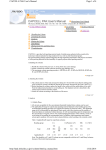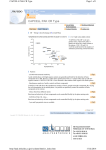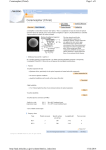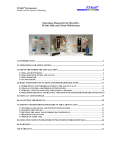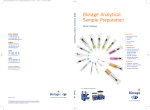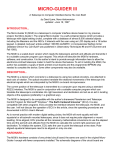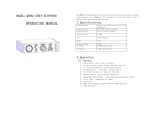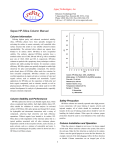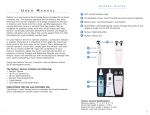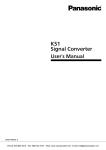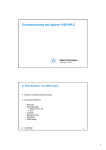Download Page 1 of 2 CAPCELL PAK C18 MGIII Type 13.02.2014 http://hplc
Transcript
CAPCELL PAK C18 MGIII Type Page 1 of 2 List of Sales Representatives Contact Shiseido HPLC Columns HPLC Instruments Application Data Catalog List About MGIII··· The third generation of the MG series was developed to overcome the "Column-to-column variation in retention of basic compounds under an acidic condition". We hope that the quality of MGIII will help develop improved methods in various LC-MS applications. Large-Diameter Columns and Preparative Devices Intended to be the "standard" for LCMS While it is based on the identical silica used in other MG series, CAPCELL PAK C18 MGIII possesses a weaker hydropobicity and a stronger surface polarity, and is suitable for a wide variety of applications, such as analyses of metabolites and other highly polar compounds. Especially, its reproducibility in retention times of basic compounds under acidic conditions is a preferred feature for long time-span applications, such as clinical analyses with LC-MS, and applications under GLP. (MGIII's specifications include a separation performance of amitriptyline under an acidic condition.) Purification Services Adobe Acrobat Reader is required to view PDF files. Click here to download Adobe Acrobat Reader. Features An example of column-to-column variation under an acidic condition is shown in Figure 1. The compound used here was amitriptyline, a highly basic compound used for the USP evaluation method. The results were obtained under an isocratic condition (0.1% formic acid / methanol). Retention times of the three columns (Column A, anonymous) were found very different under the mobile phase that was one of the most common in LC-MS. The similar tendency was also found in many other columns. We carried out a comprehensive study to understand the phenomenon of tR variation, including effects of metal impurities, reagent grade of mobile phase solvents, and byproducts in the process of stationary phase synthesis. After eliminating one possible cause after another, we reached a conclusion that the responsible factor was either 1) the synthetic byproducts and the residues of impurities from reagents used for the synthetic process, or 2) isolated silanol http://hplc.shiseido.co.jp/e/column/html/mg3_index.htm 13.02.2014 CAPCELL PAK C18 MGIII Type Page 2 of 2 groups on the stationary phase surface1. For the former, a special method to clean and condition columns (pre-conditioning, PC) was invented. The PC process was intensively studied, and one of the results was shown in Fig.2, where the relation of the duration time of PC and tR of amitriptyline was clearly observed. The retention time of naphthalene, a conventional indicator for overall retention of C18 columns, did not change at all, while tR of amitriptyline gradually increased with the PC time, and reached the plateau after a certain time. Solid-state 29Si-NMR, a useful tool to directly observe different silanol groups on the surface, did not show a significant difference between before and after the PC process (Fig.3), which suggested the residues of unwanted substances were the most responsible to the tR variation of amitriptyline. Based on these results, we confidently applied the PC process to all of the MG columns, and decided to launch the columns as "MGIII" series. The followings are some of characteristic applications obtained with the MGIII series. Therefore, the special PC process provided the stable retention to both of basic amitriptyline and neutral naphthalene. Ref. 1) J.J.Kirkland coworkers., J.Chromatogr., 352 (1986) 275. · Excellent reproducibility · Comparison of column bleeding · Separation of organic acids · Also available worldwidely · GLP/GMP-Supporting column · Categorized as L1 in USP Property values Pore size (nm) Particle size (μm) Specific Surface area (m2/g) C% Density (μmol/m2) Functional group Acceptable pH USP 10 3 300 15 2.3 Octadecyl group 2-10 L1 10 5 260 15 2.7 Octadecyl group 2-10 L1 http://hplc.shiseido.co.jp/e/column/html/mg3_index.htm 13.02.2014 CAPCELL PAK User's Manual Page 1 of 4 Microcolumn User's Manual MG Series (MGIII, MGII, MG) / UG / SG / AG / CR / UHPLC columns (IF2, IF, MGIII-H) To Top of HPLC Columns HPLC Columns HPLC Instruments Large-Diameter Columns and Preparative Devices List of Sales Representatives Contact Shiseido Technical Materials Catalog List 1.Handling the Column 2.Attaching the Column 3.Analysis 4.Storing the Column 5.End Fittings 6.Replacement Parts and Repair Items 7.Troubleshooting Purification Services Adobe Acrobat Reader is required to view PDF files. Click here to download Adobe Acrobat Reader. CAPCELL is provided with packing material made of totally porous spherical silica coated with a mono-layer silicone-polymer having octadecyl (C18) as well as other functional groups. The epoch-making packing material integrates the high separation performance and pressure resistance of silica packing material and the durability of organic polymer-based packing material. 1.Handling the Column 1. Handle the column with great care. A strong shock may cause damage. 2. Attach or detach the column when the pressure gage indicates zero. 3. The maximum column operating pressure is 100 MPa for IF2, 50 MPa for MGIII-H, 40 MPa for IF, and 20 MPa for others. 2.Attaching the Column 1. The column joint is of the male nut type for tubing of 1/16 inch OD. Check that the tubing joints of the system fit correctly and that the ferrule tips are deeply inserted into the joints. (See Fig. 1.) 2. Before attaching the column, replace the liquid in the system with the mobile phase to be used. Note the replacement procedure to avoid salting out. The shipment solvent is described in the column report enclosed with the column. 3. Attach the column according to the direction of the arrow. 3.Analysis 3-1.Mobile Phase 1. All solvents acceptable for the conventional chemically bonded silica columns can be used. 2. The applicable pH range for capsule-type packing material depends on the bonding group. The recommended operating pH ranges for Capcell Pak columns are listed in Table 1. The applicable range of pH is determined by operating pH limits under which the retention and the number of theoretical plate are maintained without decrease. It will vary depending upon the temperature and the concentration of organic solvent. For continued high performance of the columns, ensure to avoid using pH exceeding the recommended ones. In addition, high temperature and organic solvent-poor condition will result in short column lifetimes when working at the extremes of pH. Table 1 Applicable pH range for capcell pak columns Bonding group C18 UG Type ACR MG AG Applicable pH 1~10 2~10 C8,Phenyl,C1,CN UG NH2 C18+SCX UG IF AQ SG DD AG SG SG CR 2~9 1.5~10 2~10 2~9 2~8 2~7 Note: The durability of C1 and CN column are not comparable with that of C8 and Phenyl columns because of their short function groups. http://hplc.shiseido.co.jp/e/column/html/cp_manual.htm 13.02.2014 CAPCELL PAK User's Manual Page 2 of 4 3. After full degassing, filtrate the mobile phase using a membrane filter 0.45 µm or smaller to remove dust. 4. A 2-µm filter is used at the column inlet. To prevent foreign matter from clogging the column inlet filter, we recommend using a line filter. 5. The mobile phase stated in the report is sealed in a new column. To change to a mobile phase containing inorganic salt, note the replacement procedure to avoid the salting out. 6. Ion-pair reagent will slightly result in short column lifetimes 7. AQ column is applicable 100% aqueous mobile phase. However, the column lifetime will extremely vary depending upon the HPLC conditions. It is known that acidic phosphate buffer will provide better column lifetimes. 8. To prevent column deterioration, avoid the following: ·Frequent change of the mobile phase composition ·Rapid change in pressure of column inlet ·Continued using at pressure exceeding 15 MPa (100 MPa for IF2, 40 MPa for IF, and 50 MPa for MGIII-H) ·High column pressure due to the use of a high-viscosity mobile phase ·Prolonged water flow 3-2.Preparing a Sample Solution 1. Dissolve the sample in a solvent of the same composition as the eluate wherever possible. 2. Using a solvent with strong dissolving power may lower the separation efficiency or cause the sample to precipitate at the column head. 3. If there is insoluble matter remaining in the sample solution, filtrate the solution using a filter 0.45 µm or smaller. 4. The pH of the sample solution should be set in acceptable pH range for packing material. 3-3.Notes on Analysis Columns of CAPCELL PAK series generally show similar separation profiles to those of corresponding conventional silica-based columns, although slight selectivity difference may be observed depending on the analyte. When optimizing the conditions for compounds already done with conventional columns, use the same condition as a starting one. (1)When using C18,C8,Phenyl,C1,or CN 1. Regarding the guard column: Use a column of the same packing material as the main column. If a guard column of different packing material or the chemically bonded silica column of a different manufacturer is used, a separation profile may not be as expected. 2. To analyze basic compounds which are protonated under neutral conditions, peak shapes became sharper according to the buffer concentration and amount of organic solvent in mobile phase. 3. If analysis is performed with a neutral or acidic mobile phase after using a basic or strongly acidic mobile phase, retention times and peak shapes of basic compounds may become unstable. (2)When using NH2 1.Analysis of carbohydrate · Set the mobile phase conditions for a mixed solution of acetonitrile and water. As the acetonitrile concentration is higher, the carbohydrate retention is greater. · If methanol or buffer solution is used for the eluate, peaks have a tendency to broaden. · When you try to reproduce the same separation already done with NH2 columns of other manufactures, raise the acetonitrile content by 5vol% from their conditions. · Avoid using 100% water in preparing carbohydrate samples. Sample solutions of 100% water deteriorate peak shapes by the nature of normal-phase chromatography. Prepare carbohydrate samples in order to contain acetonitrile for more than 50%. 2.Analysis of ionic substance · Set the mobile phase conditions with a well-defined pH value by the use of buffer. · When optimizing pH, begin with a high pH, then lower it as needed. Once mobile phase of low pH was used, the surface of packing material will be changed irreversibly. · It may take a long time (24 hours or more) to equilibrate the column. Since the equilibrating time depends on the flow volume and the salt concentration, allow the mobile phase to remain at a high flow volume or the same pH and high salt concentration in urgent cases. · Ascorbic acid may show peak tailing. · Allantoin does not ionize in the pH range from 2 to 8. However, the use of a phosphate buffer solution is advised. Example of mobile phase: Acetonitrile/water = 80/20, 5 mmol/L KH2PO4, pH = 2.0 (H3PO4) (3)When using CR Packing material of CR is a mixture of C18 and SCX. In ion exchange mode, the following factors will change elution behavior significantly. · pH (pH should ideally be 2.0 or more away from pKa for full ion separation from the sample) · Salt concentration · Amount of organic solvent http://hplc.shiseido.co.jp/e/column/html/cp_manual.htm 13.02.2014 CAPCELL PAK User's Manual Page 3 of 4 · Salt type 4.Storing the Column 1. Seal the column with the accessory plug and store it in a cold place where there is little temperature fluctuation. 2. Replace the column with solution of organic solvent and water having the same composition as the mobile phase after using solvents containing strong organic acids such as TFA or basic solvents. (Do not use 100% water.) Moreover, for storage of one week or longer,replace the column with acetonitrile. 3. For storage within one month after using, replace the mobile phase with a solution of organic solvent and water having the same composition as the mobile phase and then fill it with the solvent used at the time of shipment. (Refer to the column report.) 4. Avoid using 100% water to rinse a column that is other than AQ. 5.End Fittings 1. An analytical column of up to 6-mm ID uses a filter-embedded end fitting as shown in Fig. 1. The filter cannot be changed alone. If the filter is clogged or the column pressure is high, replace the end fitting. See Table 3 for the replacement parts and repair items. 2. See Fig. 1 for the column connection. If the tubing is inappropriate, especially if a tube for a different type of column is used, the length after the ferrule tip (V in Fig. 1) is often different from the end fitting length L, and a problem may occur. If L is greater than V, dead volume may be generated and cause peak broadening or tailing or deterioration of separation performance. If L is smaller than V, liquid may leak because of inadequate ferrule adhesion. Therefore, we recommend replacing the ferrule together with the column. *If the column is replaced frequently, the male nut may crush the ferrule and liquid may leak. Since tightening the nut too much may cause its head to come off, replace the ferrule at an early stage. 【Fig. 1】 Column connection 6.Replacement Parts and Repair Items Table 3 Replacement parts and repair items Part No. Part Name Description 21105 End fitting (4.6 mm) 2 pieces 21107 End fitting (6 mm) 2 pieces 21110 Ferrule (1/16) Ferrules (1/16)10pieces 7.Troubleshooting Problems in high performance liquid chromatography are attributable to various causes that cannot all be listed up. The table below describes some comparatively common problems related to the column. Symptom Cause http://hplc.shiseido.co.jp/e/column/html/cp_manual.htm Measures 13.02.2014 CAPCELL PAK User's Manual Page 4 of 4 1. Column pressure rise. Blocking with foreign matter 1. Dust or insoluble matter in the mobile phase or sample solution. 2. Dirt in the tubing. 3. Plunger seal fragment. 4. Precipitation of sample components. • Sonicate the filter or replace it. • Filtrate the mobile phase and sample solution in advance using a membrane filter. • Attach a line filter. • Clean the tubing and replace the plunger seal. • Prepare a sample solution with the mobile phase. 2. Peak splitting, tailing, and broadening. 1. Void in the column head. 2. Dead volume due to inappropriate connections. 3. Inappropriate mobile phase conditions. • Ion suppression method: Inadequate suppression (Too much sample). • Ion-pair method: Inadequate concentration of the ion-pair agent (Too much sample). 4. Column deterioration. * Not repairable in the case of column deterioration or damage to the packing condition. •Reconnect the tubing. •Review the pH, salt concentration, sample amount, and other conditions. •Review the ion pair agent concentration, pH, sample amount, and other conditions. •Check the column performance using standard inspection solution. 3. Retention time too long or unstable. 1. Liquid leak (Indicated on the pressure gage of the pump). 2. Inappropriate mobile phase conditions. 3. Inadequate column equilibration time. • Check the pump and tubing for any leaks. • Secure adequate equilibration time. 4. Retention time too short. 1. Hydrolysis (deterioration) of a bonded groups by strong acid or base. 2. Inappropriate mobile phase conditions. 3. Inadequate column equilibration time. • Secure adequate equilibration time. CAPCELL PAK is shipped after a strict performance check. However, if you should find any defect, please contact your dealer or Shiseido for replacement. Note that Shiseido does not warrant the product against column life or deterioration caused by the failure to follow the above handling instructions. Ten or more days after reception by the customer, Shiseido will assume that the product was delivered in good condition, and will not accept a later replacement request. 2008 / 10 / 1 2nd edited 2011 / 8 / 1 http://hplc.shiseido.co.jp/e/column/html/cp_manual.htm 13.02.2014






















